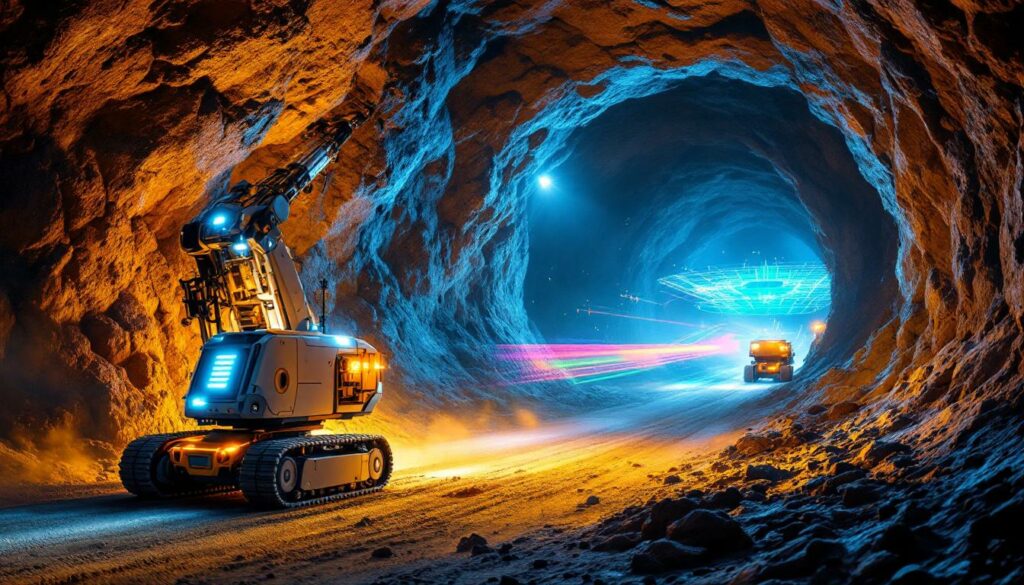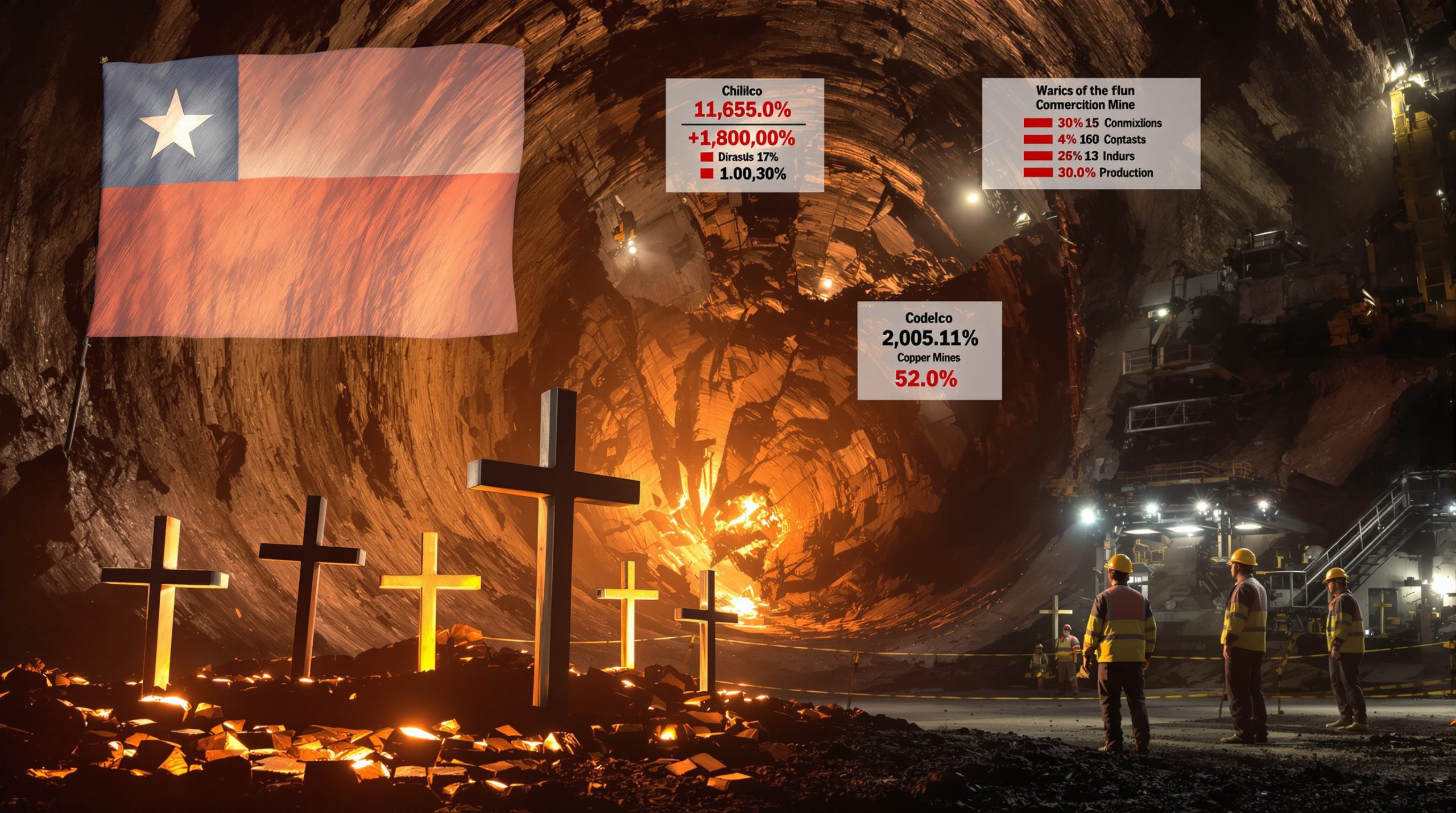How Are Robotics Revolutionizing Mining Safety?
The mining industry has historically been one of the most dangerous sectors for workers, with hazards ranging from cave-ins and toxic gas exposure to heavy machinery accidents. However, the integration of advanced robotics is dramatically transforming safety protocols and outcomes across global mining operations.
Minimizing Human Exposure in Hazardous Environments
Traditional mining operations regularly expose workers to life-threatening conditions including unstable ground, noxious gases, and dangerous machinery. Modern robotics technology is changing this reality by creating a critical buffer between humans and these hazards.
Autonomous robots now handle high-risk extraction activities that once required human presence, with specialized inspection units examining potentially unstable areas after blasting. Remote operation systems enable skilled personnel to control equipment from safe distances, sometimes hundreds of kilometers away from active mining zones.
Australian Droid and Robot (ADR) has emerged as an industry leader, developing robots specifically designed to navigate collapsed or unstable mine sections. These specialized units can access narrow passages measuring just 300mm in diameter, spaces that would be impossible for human workers to safely enter.
"Our robotic systems can operate in zero-visibility conditions with toxic gas present, situations where sending in human inspectors would be unconscionable from a safety perspective," notes an ADR engineering lead.
The impact of these technologies extends beyond emergency scenarios, creating safer day-to-day operations throughout the mining lifecycle.
Implementing Autonomous Inspection Technologies
Modern mining operations increasingly deploy sophisticated robotic inspection systems equipped with advanced sensing capabilities:
- LiDAR technology creates precise three-dimensional maps of underground environments, identifying potential structural weaknesses invisible to the human eye
- Multi-sensor arrays continuously monitor gas concentrations, temperature fluctuations, and ground stability metrics
- Real-time monitoring capabilities alert operators to developing hazards before they escalate to critical situations
The Rhino robot exemplifies these capabilities with its comprehensive underground navigation system. This advanced unit creates detailed spatial maps highlighting potential danger zones while operating continuously without experiencing fatigue or attention lapses.
According to safety data from multiple implementation sites, these autonomous inspection technologies have contributed to a 43% reduction in critical safety incidents where deployed consistently over a two-year period.
What Efficiency Gains Do Robotic Systems Deliver?
Beyond safety improvements, mining robotics deliver substantial operational efficiencies that transform productivity metrics and financial outcomes.
Automating Repetitive and Precision-Critical Tasks
Robotic systems excel at handling repetitive operations that traditionally lead to human fatigue and potential errors. The precision and consistency of these systems translate directly to measurable efficiency gains:
| Task Type | Human Operation | Robotic Operation | Efficiency Improvement |
|---|---|---|---|
| Drilling | Variable precision, fatigue-limited | Consistent precision, 24/7 capability | 30-40% increased throughput |
| Material Transport | Speed limitations, safety concerns | Optimized pathfinding, continuous operation | 25-35% reduced cycle times |
| Sorting/Processing | Inconsistent quality control | AI-powered precision sorting | 15-20% improved resource recovery |
Automated drilling systems maintain optimal parameters throughout operations, significantly reducing material waste while increasing extraction speed. This precision simultaneously improves safety by keeping workers away from drilling zones where rockfalls and equipment hazards pose significant risks.
Mining companies implementing comprehensive AI in drilling & blasting solutions report not only productivity gains but also reduced energy consumption—typically 12-18% lower than conventional operations due to optimized bit engagement and reduced idle time.
Enhancing Operational Intelligence Through Data Collection
Modern mining robots function as mobile data collection platforms, gathering critical operational insights through integrated sensor systems:
- Environmental sensors continuously monitor air quality, temperature, and structural stability indicators
- LiDAR and imaging systems create detailed spatial maps that evolve in real-time as mining progresses
- Equipment performance monitors track maintenance needs and operational efficiency metrics
This wealth of real-time information enables data-driven mining operations to:
- Respond rapidly to emerging safety concerns before they escalate
- Optimize extraction patterns based on detailed geological data
- Implement predictive maintenance to prevent costly equipment failures
- Reduce environmental impact through precise resource management
Key Insight: The integration of AI-powered analytics with robotic data collection creates a continuous improvement cycle, where operational decisions become increasingly refined and optimized over time.
According to research from McKinsey & Company, mining operations leveraging comprehensive data analytics from robotic systems achieve 20-30% lower operational costs compared to traditional mining approaches.
How Are Major Mining Companies Implementing Robotics?
Leading mining corporations have recognized the transformative potential of robotics, implementing large-scale initiatives that demonstrate the practical applications of these technologies.
Fortescue's Autonomous Vehicle Initiative
Fortescue Metals Group has invested over $1.7 billion in transitioning to electric, self-driving mining vehicles across their Western Australian operations. Their comprehensive robotics strategy includes:
- Conversion of traditional haul trucks to autonomous operation, with over 183 vehicles now operating without drivers
- Implementation of electric vehicle technology that has reduced diesel consumption by 36 million liters annually
- Development of integrated command centers in Perth that remotely manage equipment operating 1,200km away in the Pilbara region
This initiative simultaneously improves operational efficiency while reducing the company's carbon footprint, demonstrating how robotics can address both productivity and sustainability challenges in modern mine planning.
"Our autonomous haulage fleet has delivered a 30% productivity improvement while significantly reducing safety incidents related to driver fatigue," states Fortescue's Chief Technology Officer. "This technology forms the backbone of our pathway to net-zero emissions by 2030."
Rio Tinto's "Mine of the Future" Program
Rio Tinto has pioneered remote operations through their innovative program that began in 2008 and has expanded significantly since:
- Manages automated mining equipment from centralized control facilities in Perth
- Deploys autonomous drilling systems that have completed over 5 million meters of drilling
- Operates the world's largest autonomous rail network (AutoHaul™) covering 1.5 million kilometers annually
Rio Tinto's approach has proven particularly valuable in remote regions where skilled labor shortages present operational challenges. By centralizing control operations, they've improved safety outcomes while maintaining production efficiency even in difficult-to-access mining locations.
The company reports their autonomous drill systems have achieved an 11% increase in meters drilled per hour compared to conventional operations, while reducing maintenance costs by approximately 8% through optimized operation.
What Challenges Must Be Overcome for Robotic Integration?
Despite compelling benefits, the integration of robotics into mining operations presents significant challenges that must be addressed for successful implementation.
Economic and Implementation Barriers
The transition to robotic mining systems requires substantial investment and complex integration:
- High initial capital requirements ranging from $5-20 million for comprehensive systems
- Integration complexities with existing operations and legacy equipment
- Specialized maintenance needs requiring new technical expertise
- Cybersecurity vulnerabilities that weren't considerations in traditional mining
According to Deloitte's 2023 mining industry report, 60% of mining companies identify cybersecurity as a primary concern when implementing connected robotic systems. These concerns are well-founded—a 2022 ransomware attack on an Australian coal mine's autonomous fleet resulted in a three-day operational shutdown and approximately $15 million in lost production.
Smaller mining operations particularly struggle with funding these transitions, creating potential competitive disadvantages as larger corporations advance their technological capabilities. Industry partnerships and phased implementation approaches can help address these financial barriers.
Workforce Transition Requirements
The shift toward automated operations necessitates significant workforce changes that present both challenges and opportunities:
- Retraining programs for existing employees to manage robotic systems
- Development of specialized technical roles for maintenance and programming
- Creation of remote operation centers requiring different skill sets
- Potential workforce reduction in certain operational areas
Rio Tinto has invested over $20 million in retraining programs to help traditional equipment operators transition to remote management roles. This approach has helped maintain employment levels while shifting the nature of work to safer environments.
"The greatest barrier to robotic adoption isn't the technology itself but the human element—ensuring workers have the skills and confidence to work alongside and manage these systems," notes a Deloitte mining sector specialist.
Mining companies must carefully manage this transition to avoid workforce disruption while ensuring they develop the technical capabilities needed for future operations.
Environmental and Durability Considerations
Mining environments present unique challenges for robotic systems that exceed typical industrial conditions:
- Extreme temperatures ranging from -20°C in high-altitude mines to over 50°C in deep operations
- High humidity and corrosive conditions that threaten electronic components
- Dust and particulate matter requiring specialized filtration systems
- Vibration and impact risks during normal operations
These conditions demand purpose-built robotic solutions with enhanced durability features, often increasing development costs and maintenance requirements. Modular designs that allow for rapid component replacement have proven most effective in maintaining operational continuity.
CSIRO research indicates that mining robots typically require protective materials that cost 30-40% more than standard industrial robots due to these extreme operational conditions.
What Does the Future Hold for Mining Robotics?
The trajectory of mining robotics points toward increasingly sophisticated and autonomous systems that will fundamentally transform the industry.
Advancing Autonomous Capabilities
The next generation of mining robotics will likely feature:
- Enhanced AI decision-making capabilities requiring minimal human oversight
- Swarm robotics approaches where multiple machines coordinate autonomously
- Self-diagnosing and self-repairing systems that minimize maintenance downtime
- Biomimetic designs that incorporate natural adaptations for extreme environments
Sandvik's collaborative drilling prototypes demonstrate how swarm principles can be applied to mining operations. Their system coordinates multiple smaller drilling units that work in concert, potentially replacing larger, less maneuverable equipment while improving extraction precision.
These advancements will enable fully autonomous mining operations where human involvement focuses primarily on strategic planning rather than day-to-day management.
Integrated Sustainable Mining Practices
Future robotic systems will increasingly incorporate sustainability features that address mining's environmental impact:
- Precision extraction technologies that minimize waste material and reduce tailings by up to 25%
- Energy-efficient operations through optimized movement and resource utilization
- Reduced water consumption through sensor-controlled processes
- Minimized land disturbance through more concentrated extraction methods
This integration of environmental considerations with productivity improvements represents a fundamental shift in how mining operations approach resource extraction.
Recent implementations at Newmont's operations demonstrate how precision extraction through AI-powered efficiency can reduce water usage by approximately 15% while improving mineral recovery rates.
Industry-Wide Transformation Outlook
The mining sector appears poised for comprehensive transformation through robotics, following a progressive adoption pattern:
- Initial adoption focused on safety improvements in high-risk areas
- Expansion to efficiency-critical operations like drilling and haulage
- Integration of data systems across all operational aspects
- Development of fully autonomous mining sites with minimal on-site personnel
According to the International Council on Mining and Metals (ICMM), approximately 75% of major mining companies have robotics implementation roadmaps extending to 2030, suggesting an industry future where traditional mining approaches become increasingly rare.
How Can Mining Companies Prepare for Robotic Integration?
Successful adoption of mining robotics requires strategic planning and capability development to maximize benefits while minimizing disruption.
Developing Strategic Implementation Plans
Effective robotic integration requires comprehensive planning that addresses:
- Phased technology adoption timelines aligned with capital investment capabilities
- Clear metrics for measuring safety improvements and operational efficiencies
- Integration strategies for combining robotic and human workforce elements
- Cybersecurity frameworks based on NIST standards for industrial control systems
Companies should begin with targeted implementations in high-risk or high-inefficiency areas before expanding to broader operational aspects. EY's 2023 mining automation study indicates that phased approaches typically achieve positive ROI 30% faster than comprehensive overhauls.
Building Technical Capabilities and Partnerships
Mining operations benefit from developing:
- Internal technical expertise through targeted hiring and training programs
- Partnerships with robotics developers and systems integrators
- Collaborative relationships with educational institutions for workforce development
- Knowledge-sharing initiatives across industry participants
These capabilities provide the foundation for successful long-term adoption of increasingly sophisticated robotic technologies. Mining companies that establish dedicated innovation teams report 40% faster implementation cycles for new technologies.
Creating Adaptable Operational Frameworks
Future-ready mining operations require:
- Flexible infrastructure designed to accommodate evolving robotic systems
- Scalable data management capabilities for processing increasing information volumes
- Adaptable workforce management approaches that evolve with technological change
- Continuous education programs that keep technical teams current with emerging technologies
This adaptability ensures mining companies can continuously incorporate new robotic capabilities as they become available, maintaining competitive advantage in a rapidly evolving mining innovation trends landscape.
FAQ: Mining Robotics and Automation
What are the primary safety benefits of mining robotics?
Mining robotics significantly reduce human exposure to hazardous environments including unstable ground, toxic gases, and heavy machinery operation zones. Autonomous systems can operate in dangerous areas while being monitored from safe locations, dramatically reducing accident risks while maintaining productivity. Implementation data shows typically 40-60% reduction in recordable safety incidents within the first 24 months of comprehensive deployment.
How do robotic systems improve mining efficiency?
Robotic mining systems improve efficiency through continuous operation capabilities, precision control that reduces waste, optimized movement patterns that save energy, and integrated data collection that enables ongoing process refinement. These systems typically achieve 20-40% productivity improvements compared to traditional methods, with the highest gains in drilling, haulage, and sorting operations.
What types of robots are currently used in mining operations?
Modern mining operations employ various robotic systems including autonomous haulage trucks, robotic drilling platforms, inspection drones and ground robots, automated conveyor and sorting systems, and remote-controlled excavation equipment. Each system addresses specific operational challenges while contributing to overall safety and efficiency improvements. The most widely adopted technologies are autonomous haulage (implemented by 42% of major miners) and automated drilling systems (39% adoption rate).
How quickly can mining companies expect returns on robotics investments?
Return on investment timelines vary based on implementation scope and existing operations, but most mining companies report ROI periods of 2-5 years for major robotic systems. Safety improvements often deliver immediate cost savings through reduced incidents, while efficiency gains typically build progressively as systems are optimized. Larger operations with economies of scale generally achieve faster returns (averaging 3 years) compared to smaller operations (5+ years).
What environmental benefits do mining robots provide?
Robotic mining systems offer several environmental advantages including more precise extraction that reduces waste material (typically 15-25% improvement), optimized energy usage through efficient movement patterns (10-20% energy reduction), reduced water consumption through better process control (8-15% savings), and minimized habitat disruption through more concentrated operations. These benefits contribute significantly to mining companies' sustainability goals and regulatory compliance.
Want to Profit From the Next Major Mineral Discovery?
Discovery Alert's proprietary Discovery IQ model instantly notifies investors of significant ASX mineral discoveries, transforming complex data into actionable insights that could lead to substantial returns. Explore historic examples of exceptional outcomes by visiting Discovery Alert's dedicated discoveries page and begin your 30-day free trial today to position yourself ahead of the market.




